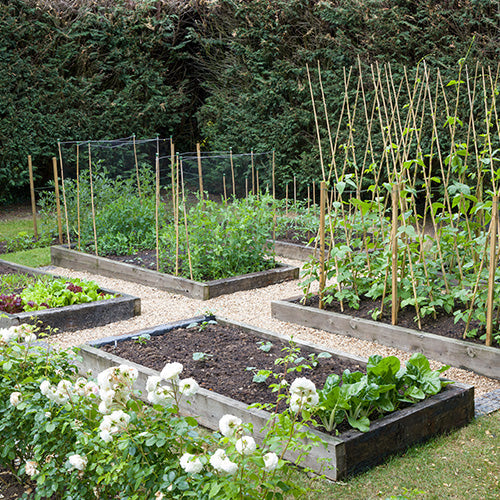If you’re wondering when to sow your seed potatoes, you should do so around late March for first earlies, early to mid-April for second earlies and mid-to-late April for maincrops.
Planting too early in cold, wet soils may cause rotting. So, we recommend you delay planting until the soil is both warm and moist to the touch. In most areas, this is in the March to May period.
There are numerous ways of growing potatoes. The traditional way is to dig a narrow trench 10-15cm/4-6in deep. This can be lined with compost or even grass clippings for a better crop. The seed tubers should be spaced 35cm/14in apart, with rows 45cm/18in apart for early varieties. Maincrop varieties should be spaced 38cm/15 inches apart, with rows 75 cm/30 inches apart.
You should sprinkle slug pellets or other slug control products between the tubers, as slugs can be a problem.
Chitting Potatoes
The chitting process allows strong green shoots (known as chits) to develop on the seed potato tuber before planting. Although not essential, it is particularly beneficial for earlier cropping potatoes because it gives the potato a quick start, thus cropping slightly earlier. Later cropping potatoes are less likely to need chitting as warmer soil temperatures can make a greater difference.
Start chitting (where necessary) by setting the seed potatoes out, side by side, blunt end uppermost, in single layers in seed trays or a wooden box. Place in a light, cool, well-ventilated spot to encourage the development of stocky shoots 2-2.5cm/¾-1in long, when they will then be ready for planting.
For large potatoes, rub off all but the three strongest shoots before planting. For maximum yields, leave all the shoots in place. Alternate potatoes can be rubbed in the row for the best of both worlds: a high yield and larger, individual tubers.
For further advice on chitting potatoes, take a look at our customer FAQs on chitting potatoes, covering a variety of common queries.
Growing Potatoes from Containers
It is possible to grow potatoes in containers, or even black bin liners, if you have limited space or no open ground to grow them in. Line the bottom 15cm/6in of the container with potting compost, and plant the seed tuber just below this. As the new stems start growing, keep adding compost until the container is full.
For further details on using potato grow sacks, take a look at our guide on how to grow potatoes in a container.

 How to Grow Potatoes from Seed Potatoes
How to Grow Potatoes from Seed Potatoes

 Before Planting…
Before Planting…

 Ground Prep
Ground Prep

 How to Plant Seed Potatoes
How to Plant Seed Potatoes

 When to Harvest Potatoes
When to Harvest Potatoes

 Problems
Problems

How to Grow
Ground Preparation
Sowing
Planting
Harvesting
Problems
















Leave a comment
All comments are moderated before being published.
This site is protected by hCaptcha and the hCaptcha Privacy Policy and Terms of Service apply.